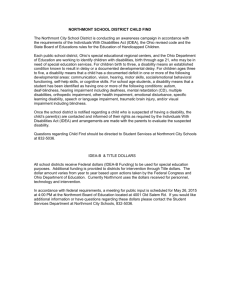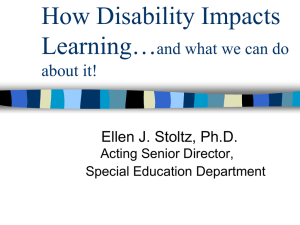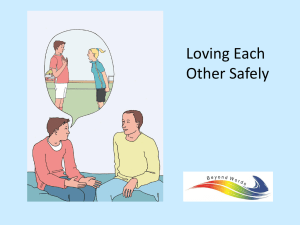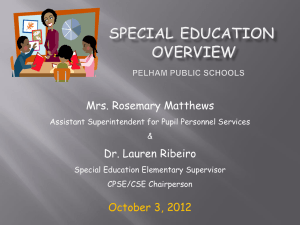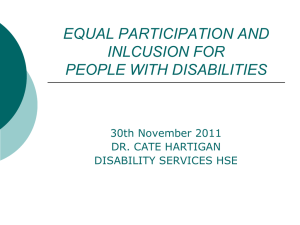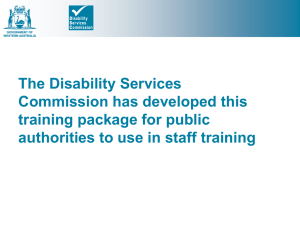Disability Sensitivity Training
advertisement
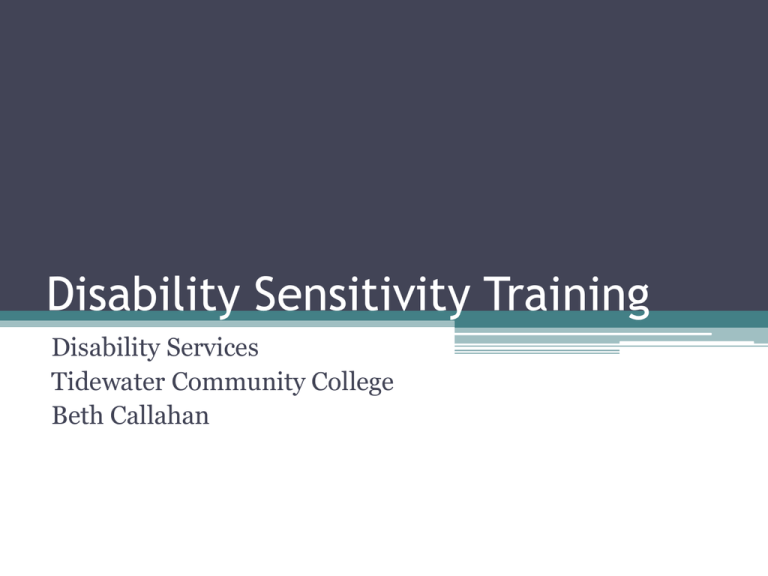
Disability Sensitivity Training Disability Services Tidewater Community College Beth Callahan Purpose of Disability Training Heighten the awareness of barriers that influence academic performance, productivity, and major life skills of people with disabilities. Disability defined… • Any individual who provides objective evidence of a physical or mental impairment that substantially limits one or more of the major like activities such as: ▫ Walking ▫ Seeing ▫ Hearing ▫ Speaking ▫ Breathing ▫ Learning ▫ Working Disability Facts • There are over four hundred students on the Virginia Beach campus with a documented disability. • College students with disabilities are less likely to complete their degree programs than students without disabilities (Stodden, 2001). • There are over 500 known disabilities. Common disabilities include: vision, hearing, speech, physical and developmental. Disability Facts continued… • 1 out of every 6 people in the United States reports having a disability (U.S. Census Bureau, 2008). • 1 out of every 9 first-year post-secondary student reports having a disability (U.S. Dept. of Education 2003-2004). Disability vs. Handicap A disability is a condition that limits a person’s ability to walk, talk, see, hear, or learn. A handicap is an imposed barrier that restricts a person. It is up to everyone to help make sure disabilities are seen as challenges and not burdens. Words Are Powerful Tools • The words we use reflect how we believe. It is important to always refer the “person with the disability”-always place person first. • Don’t underestimate people with disabilities. It is wrong to assume a person’s physical disability has lessened his or her mental ability. • Avoid labels. Never refer to people by their disability. For example, don’t say “the handicapped, the crippled, the blind.” People Who Are Visually Impaired • Always identify yourself and other who may be with you when meeting someone with a vision impairment. • Never touch someone with a vision impairment unless they know that you are there. • Offer your arm-don’t propel or lead a person with a vision impairment. • When accompanying a person with a visual impairment offer to read signs, menus, etc. Student Quotes “People scream at me and slow down their speech when they find out I can’t see.” “Don’t be afraid to use words like ‘look’ or ‘see’ when you are around me.” People with Physical Disabilities • Do not lean or hang on someone’s wheelchair. People with physical disabilities treat their wheelchairs as extensions of their bodies. • Never patronize people who use wheelchairs by patting them on the head. • Never move adaptive equipment outside the person’s reach. • Place yourself at eye level when speaking to someone using a wheelchair. Student Quotes • “If you talk to me please meet my eye level if possible, it is uncomfortable to keep looking up.” • “It’s okay to ask if I need assistance, but don’t assume.” • “Don’t be afraid to use words like ‘walking’ or ‘running’ around me.” People Who Are Deaf or Hard of Hearing • Use body language. It offers clues to what you are saying. • Ask the person how they would prefer to communicate (lip read, sign, write notes, etc.) • Look directly at the person and speak clearlynever shout at a person with a hearing impairment, just speak in a normal tone. Student Quotes • “Most people don’t know that when you lip read you can only understand about 25-30% of spoken English.” • “Talk to me, not the interpreter.” • “It’s okay to ask me to repeat something I’ve said, just don’t pretend you understand.” General Suggestions • Do not be afraid of saying or doing the wrong thing. It is better to communicate with a person with a disability and say the wrong thing than to ignore or avoid contact completely. • Do not feel that students with disabilities are getting “unfair” advantages. Accommodations help to even the playing field. • Recognize that a person with a disability may give you a unique and new perspective in school or life. People face different barriers everyday. Some are physical while others are “attitudinal”. Treat all people with patience, an open mind and flexibility as well as the respect and dignity you expect for yourself. Living in a Diverse World • Diversity means variety in race, gender, ethnicity, age, physical and mental abilities and sexual orientation. “Non-traditional Student” • Works full time or part time will attending community college • Commutes to school • Is of a racial or ethnic minority • Is a parent • Has little time for extra curricular activities • Is the first in the family to go to college • Comes from outside the United States What is your most embarrassing moment? • How did you feel? • Imagine if that is how you felt everyday. • How would you deal with that?
